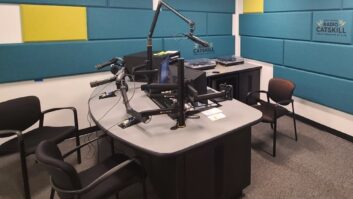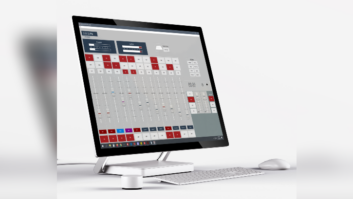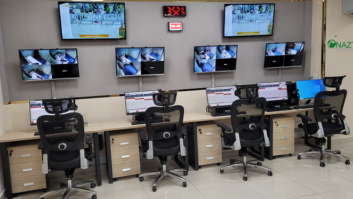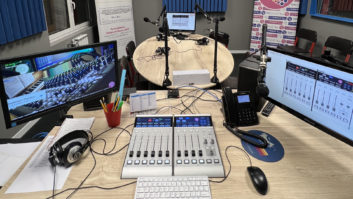If you find yourself tasked with specifying and designing a new studio system based on AoIP control surfaces, and routers then you should make every attempt to get yourself to Las Vegas on April 22.
In the meantime, we�ve done some preliminary research for you. This article covers the basics of systems and standards offered by the various manufacturers of AoIP systems and devices. Read on � then plan your exhibit floor time accordingly.
WHEATSTONE
Wheatstone�s LXE is available in several different form factors including countertop, countertop sunken and split frames.

Wheatstone introduced its LXE series of consoles last year at NAB Show. The LXE is a control interface for which every switch and rotary control is programmable to perform any desired function; the console architecture is completely customizable to end-user requirements.
ConsoleBuilder software allows every switch on the surface to be programmed for function, mode and even color (switches are RGB-LED illuminated). Multiple full color OLED displays on each panel show ongoing operations, and event recall allows for one-touch console reconfiguration.
The LXE-series GUI has pre-built screens for metering, clocks, timers, dynamics, EQ and buss assigns. All are touch-screen accessible to the end-user. The GUI is customizable using the ScreenBuilder-LXE software, enabling the user to drag and drop objects and define their functions via a wizard interface. Multiple custom screens can be stored to go with console configurations.
The LXE is available in several different form factors, including countertop, countertop sunken and split frames (which can actually be in different rooms). It can support up to 32 physical motorized faders, with full DSP processing available on all 32 channels. The LXE surface uses BLADE-3s for audio, control and associated logic, with a single CAT6 interconnecting cable.
The LX-24 table-top, modular control surface (operating in conjunction with the IP88E Mix Engine BLADE) comes with a built-in meter bridge featuring up to four sets of bright, high-resolution LED meters and circular LED displays for auxiliary send levels and pan control. The LX-24 is of a modular design and the modules that are hot-swappable. There are no electronics in the pan below the modules.
The LX-24 surface that can store and recall all user settings, and �Snapshots� of the LX-24�s configuration can be saved and recalled at the touch of a button. Each input channel can be assigned to four stereo busses, plus four pre/post-selectable aux sends, a stereo CUE bus, four mix-minuses and the panel�s own bus-minus. An LED source name display, an A/B source selector, and two programmable soft buttons are included and a SET button provides access to assignable controls in the master section.
Control room and headphone outputs with level control and source selection are provided, as well as two independent studio monitor outputs. Stereo CUE speakers are built into the meter bridge. Headphones and CUE are delivered to the surface right from the IP network. On-board VGA and USB Mouse connectors allow a monitor and mouse to be connected to the console for configuration and advanced console functions.
There are also more economical ways to get Wheatnet-IP in to your facility as well. Consider the IP-12 as one example. Each of its 12 input modules is equipped with an LED source name display and an A/B source selector; sources can be set via a rotary encoder in the master section. Each input module has access to four program busses, and has cue and talkback switches and a 100mm long-throw fader and lighted channel ON/OFF switches.
The IP-12 control surface connects via Ethernet to its audio engine, IP88CB console audio BLADE. This 1RU device holds all of the console�s digital signal processing, input, output, and logic circuitry. It has no fans and may be located either next to the console or at a remote location. The master section offers control room, studio, and headphone controls with source selection, along with a built-in headphone jack and amplifier. Timer controls, a master talkback button and a built-in cue speaker with volume control are provided. The meter bridge has three stereo pairs of bright 30-segment horizontal LED bargraph meters, as well as an onboard timer with controls located in the master section.
Wheatstone BLADES are the 1 RU devices that interface the Wheatstone AoIP network with the outside world. I/O BLADEs convert audio and logic inputs to data streams for the network, and conversely generate analog, AES, and GPIO outputs, corresponding to data streams on the network, for use outside the network. The IP-88A-3 is the analog I/O BLADE; the IP-88D-3 is the AES I/0; the IP-88AD-3 is the mixed analog/AES BLADE; the IP-88M-3 is the mic level input BLADE; the LIO-48 is the logic I/O BLADE. Each I/O BLADE comes with a CPU and operating system giving the end-user the ability to configure features such as routable mixing and logic-follow-audio. They communicate with the network via gigabit Ethernet.
The complete interconnection of all the network devices is done by way of layer-2 (Ethernet) switches and Wheatstone maintains a list of Ethernet switches, by make and model, that are tested and approved for the WheatNet-IP network.
The Axia Fusion is a modular console available in frame sizes that support 8 to 40 faders in single or multiple linked frames.

I have mentioned WheatNet-IP several times�just how is that defined? According to Wheatstone: �Wheatnet-IP is a network system that utilizes Internet Protocol to enable audio to be intelligently distributed to devices across scaleable networks.�
WheatNet IP is AES67-compatible and furthermore �is unique in that it represents an entire end-to-end solution, complete with audio transport, full control, and a toolset to enable exceptionally intelligent deployment and operation.�
WheatNet-IP Navigator is the control and administration software package for WheatNet-IP. Much of the basic configuration of WheatNet-IP can be done from a BLADE�s front panel, but WheatNet-IP Navigator offers a more convenient way to do comprehensive system configuration, such as entering source and destination names, performing general system setup functions, programming salvos and macros, controlling audio paths, setting-up silence detection and managing failover contingencies, among other functions. As part of the system, WheatNet-IP Navigator continuously queries the network so that it�s always showing the current configuration and status. Up to four copies of Navigator can run at the same time from multiple locations.
AXIA
Let�s consider a large, medium and a small console from the Axia lineup.
The largest of the Axia control surfaces (or �consoles,� if you prefer) is the Fusion, a modular console available in frame sizes that support eight to 40 faders in single or multiple linked frames. It can use the Axia PowerStation or StudioEngine DSP mixing engines, and connects to the Axia network with a single CAT-6 Ethernet cable, allowing the sharing of local audio devices (and their associated GPIO control) among multiple studios. Fusion has four stereo Program buses, four Send buses, and two Return buses.
A variety of module types are available, from fader-only modules to Call Controller modules with integrated multi-line controls for Telos multi-line phone systems. Fusion also features VMix (Virtual Mixer) channels, which allow for the combining up to five audio sources for presentation on a single console fader.
Some of Fusion�s other features include auto-assigned, auto-generated mix-minus on each channel; individual or group talkback for remote talent cueing; one-button off-air phone record mode; and up to 99 Show Profiles console �snapshots� for set, save and recall of console layouts customized to the working style of individual shows or operators. Built-in digital EQ may be applied individually to all audio sources.
New on the show floor this year will be the Telos Alliance IP-Tablet Software, designed specifically for use with Telos Alliance products by Livewire partner J�r�me Gahery from IP-Studio. The IP-Tablet Software provides for virtualization of control and hardware resources, while simplifying and aggregating control of several Telos Alliance devices. The software can also be used to�manage user rights for device�access, linking a user profile to his or her needs and access privileges. It can replace an external monitor needed by an Axia Fusion or Element console. An optional machined aluminum panel fits right into any�Fusion console, housing a 10-inch Windows tablet,�just like a four-fader module taking up four console slots.
Wheatstone�s LXE GUI is customizable using the ScreenBuilder-LXE software.

Consider the Axia iQ if you need an intermediate-size console. It can be used to build custom consoles of sizes from eight to 24 faders. A basic system consists of one iQ eight-fader main frame and one QOR.32 integrated console engine � a DSP-based mixing engine which incorporates analog and digital audio I/O, GPIO and a custom Ethernet switch. Faders and control capabilities can be expanded by adding one or more iQ Expansion Frames (up to a maximum of three frames per console installation).
iQ features three dedicated stereo Program buses, plus a stereo Utility buss that can be used for phone�calls, off-air recording, or as a fourth Program bus. Automatic mix-minus is provided on each fader, plus talkback functions, a one-button off-air record mode, and show profile functions for instant recall of up to four pre-defined console �snapshots.� High-resolution OLED program meters are switchable between VU and PPM metering styles.
For a small console, consider the RAQ console, with six rotary faders with OLED channel options displays; two stereo mixing buses and Preview (cue) bus; a high-resolution OLED meter display with switchable VU / PPM ballistics; and monitor/headphone controls for auditioning of Program buses or two assignable External monitor source selections. RAQ also features Axia�s automatic mix-minus for phone callers and codec sources. RAQ will work in a standalone installation, but also networks with larger Axia networks. A RAQ control surface and a QOR.16 integrated console engine constitute a complete RAQ system.
You will still need to have an interface to various analog, AES or logic sources, and that�s where the xNodes come in. These are half-rack devices (1 RU in height) that are available in analog, AES/EBU, microphone-level, mixed-signal, and GPIO versions to handle all the various signals encountered in today�s broadcast environment. They�re fanless, which means they can go in the studio. xNodes are Livewire+-, Ravenna- and AES67-compliant, and according to Axia, �every xNode not only supports Ravenna audio stream interoperability, but also enables advertising/discovery of those streams natively, above and beyond AES67.�
Axia also offers zero-configuration, purpose-built-for-broadcasting Ethernet switches inside of the PowerStation, QOR.32, and QOR.16 console engines. Another option is a standalone Ethernet switch custom-built for IP-Audio known as xSwitch; and if you want to build a conventional Ethernet network for your system, Axia provides a list of recommend switches from Cisco and Huawei.
Livewire+ is the protocol developed by Axia to convey low-delay, high-reliability audio over switched Ethernet. It complies fully with the AES67-2013 Interoperability Standard, allowing AES67 devices to connect directly to Livewire+ networks and exchange audio streams. Livewire+ is also extensible, able to incorporate future AES standards when they are ratified. Livewire+ is also backward-compatible with the Ravenna networking protocol. With Livewire+, a single Ethernet cable carries real-time uncompressed digital audio, device control messages, program associated data, and even routine network traffic.
Axia�s PathfinderPC and PathfinderPRO router control software for Windows provide the tools the end-user needs to customize and command the Axia network. Another new product you�ll see at NAB this year is the Pathfinder Core PRO Routing Control and Facility Management Appliance, which, according to Axia, was �… designed from the ground up to provide pro-grade routing control that gives the user easier, more intuitive control over audio workflows.� A web interface means configuration and monitoring can be done from any device. The legacy Pathfinder software has been changed to include customizable user panels, automatic table generation, and virtual source routing.
The Pathfinder Core PRO appliance is fan-free for silent in-studio deployment and equipped with dual Gigabit Ethernet ports and dual-redundant internal power supplies. It comes equipped with�500 crosspoint and 500 logic rules; for larger facilities, an additional license can be purchased, which adds an additional 500 crosspoints or 500 rules to a Core PRO system.
HYBRID SYSTEMS
Radio Systems Millenium IP consoles offer standalone functionality and Livewire IP-Audio network connectivity.

While we talk about complete AoIP networks, it�s important to consider that many TDM router/console systems offer up AoIP interfaces, thus giving their systems a hybrid nature. Let�s take a look at a some examples.
Radio Systems is a well-known manufacturer of consoles (and of course the line of StudioHub accessories). Their Millenium IP consoles offer both stand-alone functionality and Livewire IP-Audio network connectivity, meaning that Millenium consoles can communicate with any Axia device or any Livewire-enabled device. Any digital delivery system with an�Axia iPlay driver can be connected directly to a Millenium Livewire console allowing for playback and recording of multiple audio channels with no audio card required in the playback computer. With the addition of Ethernet switches, multiple consoles can be networked together, and the system designer could make further use of Axia nodes for ingress and egress of analog and/or AES data streams. The addition of a Windows PC to the network will provide support for iPlay or the PathfinderPC system configuration or Windows Media playback.
PR&E VMXpress IP provides a means by which AoIP access is added to a new or existing Vistamax networks by allowing integration to AES67-compliant devices.

Pacific Research and Engineering�s VMXpress IP provides a means by which AoIP access is added to new or existing Vistamax networks by allowing integration to AES67-compliant devices. There are three analog models: eight stereo inputs/outputs, or eight stereo inputs/outputs plus 32 channels bidirectional logic control; or 16 stereo inputs/outputs. There are three digital models: eight AES/EBU digital inputs/outputs; or eight AES/EBU digital inputs/outputs plus 32 channels bidirectional logic control; or 16 AES/EBU digital inputs/outputs. The mixed analog/digital version comes with eight stereo analog inputs/outputs plus eight AES/EBU digital inputs/outputs.
Interfacing VMXpress to a VistaMax, VistaMax Envoy, or VMConnect frame is done via Cat-5 using the VistaLink protocol. A VistaLink �cascade� connection allows two VMXpress devices (or one VMXpress and one VMQuadra) to connect to a VMConnected Network frame via a single cable run.
Perhaps most importantly, the VMXpress IP provides a bi-directional gateway between any AES67 and Ravenna device and the VistaNet Network. Interfacing VMXpress IP to an outside network is enabled via two RJ-45 connections: One connects to a VistaMax, VistaMax Envoy, or VMConnect frame via Cat-5 via the VistaNet protocol and the other RJ-45 connects directly into the AES67 and Ravenna network switch.
SIERRA AUTOMATED SYSTEMS
Rio Bravo IP Engines are networked using standard IP infrastructure and will also interface with an SAS 32KD Network.

Sierra Automated Systems recently introduced the Rio Bravo which they refer to as an AoIP DSP Engine �studio-in-a-box.� Rio Bravo IP Engines are networked using standard IP infrastructure and will also interface with an SAS 32KD Network. A cat5 is used to connect the Rio Bravo to one of SAS�s control surfaces, such as the Rubicon, iSL, SL and MClass.
The Rio Bravo engine needs 2 RU of rack space and is designed to go in the radio studio where it will provide all the functionality normally required of a consoles system. It has six slots for installing a variety of hot-swappable I/O modules, such as analog, AES, AAC Encoded AoIP and microphone (input only) to support up to 96 discrete channels of audio I/O. There are an additional 24 resident on board outputs for common studio needs such as monitor and cue speakers, headphones and metering as well as other general purpose system functions.
Rio Bravo IP Engine consists of five digital signal processors that provide 64 mix busses, as well as effects, equalization, dynamics processing, silence and peak detectors for every channel. It has two RJ-45 jacks dedicated to network connections to an external network for communication with other devices via the Dante AoIP protocol, which also makes it AES67-compatible and ready for use with other AES67-compatible devices, as well as IEEE802.1 (AVB) compliant devices.
All configuration parameters are stored in the front panel-accessible SD card and are programmable using the built-in Web-based user interface, allowing for complete control and configuration of an entire system from a computer.
LAWO
Lawo�s R3LAY is a virtual radio mixer running in a virtualized PC environment with a multi-touch-enabled screen interface.

Lawo is another well-known manufacturer of router and control surface systems, and they too have introduced products with AoIP interfaces. R3LAY is a Virtual Radio Mixer running in a virtualized PC environment with a multi-touch-enabled screen interface. It�s meant to be used as a portable studio, with analog and digital I/O and 4- or 8-fader Virtual Mixer.
R3LAY connects with standard audio-over-IP hardware that supports the Ravenna/AES67 networking standard. It also features GPIO via open-source Ember+ control protocol; it supports native PC audio (ASIO, WASAPI, WDM, MME); it can generate mix-minus (clean feed) with talkback; it has on-screen control of user shortcuts and mixer snapshots. There are plug-in software apps for processing, playout, codecs and phones.
The R3LAY �Radio In A Bag� package includes four- or eight-fader Virtual Mixer software, OnAir4 audio I/O interface and heavy-duty travel backpack; the user supplies a Windows 10 laptop.
Lawo has a line of control surfaces and audio engines, as well. As one example, consider Sapphire compact. It�s available in either desktop or flush-mounted styles, either as a unibody frame or in splits. A 1 RU engine powers the control surface and contains the signal processing functions along with the audio inputs and outputs; as an option it is available with Ravenna/AES67 interface. Sapphire compact is available as 16 live sources with eight faders; or 24 live sources with 12 faders; or 32 live sources with 16 faders. (The engine supports a maximum of 48 mono sources active at the same time.) Outputs are formatted for stereo or a 5.1 mix.
VisTool 5.0 software is used with the Sapphire compact. It�s designed to be the central screen for information and for interaction with users, offering a customizable touchscreen with an optimized software GUI providing full control over all of the relevant functions of a sapphire mixing console. In addition it offers access to channel DSP processes like EQ, dynamics and buss routings, input parameters and fader channel control.
ARRAKIS
Front view of the Arrakis Simple-IP-8.

Arrakis offers Simple IP, a 1 RU interface that allows AoIP sources and destinations to become available to the traditional console system based on analog or AES audio. Simple IP is based on the Dante AoIP system and is thus AES67 compliant. Using the Dante standard, Simple IP can send and receive audio to any other AES67 device, whether that is a console, switcher or other compliant piece of hardware.
Simple IP comes in two versions: the eight in/ eight out mono (or four by four stereo) versions, and the four-in/ four-out AES version. If your application needs more inputs and outputs you can add more Simple IP interfaces. Simple IP interfaces with any of the Arrakis ARC or MARC series consoles.
Dante Controller is a free software application that enables you to route audio and configure Simple IP devices on a Dante network. It features automatic device discovery, one-click signal routing and user-editable device and channel labels, and works on MAC and Windows PCs. Once connected to the network, the Dante Controller interface will automatically detect each Simple IP connection within seconds. Dante will work with any Ethernet switch, but ones with Gigabit ports and QoS are preferred.
LOGITEK
Logitek will introduce new consoles and vMix virtual console software, all on an AoIP platform, during the 2017 NAB Show. A representative from the company told Radio that Logitek is �looking at the future of how consoles will be operated, especially by younger people who are accustomed to direct interaction with a screen.�
�The need for huge physical consoles is becoming a thing of the past. There is more and more automation involved, so a greater level of integration between console manufacturers and automation providers is required,� said Logitek President Tag Borland. �Future consoles from Logitek will reflect this tighter integration � they will be able to have a much smaller footprint than in the past but will be capable of accessing many incidental system features without taking up the space needed by older physical boards.
�Another important consideration for AoIP is redundancy. Logitek�s systems have been offering dual paths for some time, which improves stability and reliability of audio delivery.�
The NAB Show is the best opportunity � although not the only one � for U.S. broadcasters to see the many systems manufactured for radio, up close and personal. We�ve only scratched the surface here; each manufacturer mentioned has many more products than those mentioned in this article.
I hope this article has piqued your interest in one or more brands. Now it�s up to you to read more, to make up your list of questions, and to hit the road come April.
RESOURCES
?�www.telosalliance.com/Axia
?�www.wheatstone.com
?�www.radiosystems.com
?�www.sasaudio.com
?�www.lawo.com/applications/radio-on-air.html
?�logitekaudio.com
?�www.arrakis-systems.com












